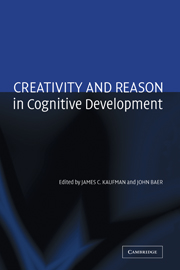Book contents
- Frontmatter
- Contents
- List of Contributors
- Acknowledgments
- Creativity and Reason in Cognitive Development
- Introduction
- COGNITIVE PERSPECTIVES
- 1 Expertise and Reason in Creative Thinking: Evidence from Case Studies and the Laboratory
- 2 Creative Genius, Knowledge, and Reason: The Lives and Works of Eminent Creators
- 3 Dynamic Processes Within Associative Memory Stores: Piecing Together the Neural Basis of Creative Cognition
- 4 The Creativity of Everyday Moral Reasoning: Empathy, Disgust, and Moral Persuasion
- 5 Reasoning and Personal Creativity
- 6 Alternative Knowledge Structures in Creative Thought: Schema, Associations, and Cases
- 7 The Role of the Knowledge Base in Creative Thinking
- 8 The Role of Domain Knowledge in Creative Problem Solving
- 9 Creative Thinking and Reasoning: Can You Have One Without the Other?
- 10 From Alexithymia, Borne of Trauma and Oppression, to Symbolic Elaboration, the Creative Expression of Emotions, and Rationality
- 11 Opening up Creativity: The Lenses of Axis and Focus
- DEVELOPMENTAL AND EDUCATIONAL PERSPECTIVES
- Author Index
- Subject Index
- References
6 - Alternative Knowledge Structures in Creative Thought: Schema, Associations, and Cases
Published online by Cambridge University Press: 19 January 2010
- Frontmatter
- Contents
- List of Contributors
- Acknowledgments
- Creativity and Reason in Cognitive Development
- Introduction
- COGNITIVE PERSPECTIVES
- 1 Expertise and Reason in Creative Thinking: Evidence from Case Studies and the Laboratory
- 2 Creative Genius, Knowledge, and Reason: The Lives and Works of Eminent Creators
- 3 Dynamic Processes Within Associative Memory Stores: Piecing Together the Neural Basis of Creative Cognition
- 4 The Creativity of Everyday Moral Reasoning: Empathy, Disgust, and Moral Persuasion
- 5 Reasoning and Personal Creativity
- 6 Alternative Knowledge Structures in Creative Thought: Schema, Associations, and Cases
- 7 The Role of the Knowledge Base in Creative Thinking
- 8 The Role of Domain Knowledge in Creative Problem Solving
- 9 Creative Thinking and Reasoning: Can You Have One Without the Other?
- 10 From Alexithymia, Borne of Trauma and Oppression, to Symbolic Elaboration, the Creative Expression of Emotions, and Rationality
- 11 Opening up Creativity: The Lenses of Axis and Focus
- DEVELOPMENTAL AND EDUCATIONAL PERSPECTIVES
- Author Index
- Subject Index
- References
Summary
A number of approaches might be used to understand how people think creatively. One might, for example, examine the performance characteristics associated with certain problem-solving tasks known to elicit creative thought (Mumford, 2002). One might try to identify the abilities people must posses if they are to solve creative problems (Sternberg & O'Hara, 1999). And, one might examine the errors people make as they work through problems calling for creative thought (Carlson & Gorman, 1992).
Although these alternative approaches all have value, process analysis remains the dominant approach in studies of creative thought (Brophy, 1998; Lubart, 2001). In process studies, an attempt is made to identify the major cognitive operations that occur as people work on the complex, novel, ill-defined tasks that call for creative thought and the production of original, albeit useful, products (Ghiselin, 1963; Mace & Ward, 2002; Ward, Smith, & Finke, 1999). The attraction of the process approach is because of both its generality and the framework provided for identifying the heuristics, or strategies, needed at each step in peoples' creative efforts.
Over the years, a number of models describing the processes involved in creative thought have been proposed (Dewey, 1910; Merrifield, Guilford, Christensen, & Frick, 1962; Parnes & Noller, 1972; Sternberg, 1985; Wallas, 1926). In a review of this literature, Mumford and his colleagues (Mumford, Mobley, Uhlman, Reiter-Palmon, & Doares, 1991; Mumford, Peterson, & Childs, 1999) identified eight core process that appeared to be involved in most real-world creative problem-solving efforts: (1) problem construction, (2) information gathering, (3) concept selection, (4) conceptual combination, (5) idea generation, (6) idea evaluation, (7) implementation planning, and (8) monitoring.
- Type
- Chapter
- Information
- Creativity and Reason in Cognitive Development , pp. 117 - 136Publisher: Cambridge University PressPrint publication year: 2006
References
- 10
- Cited by



